
Creating a tactic for Hamburg in Football Manager 22 (Part 1)
When it comes to tactics in Football Manager I used to take over a team (in this case Hamburg in Football Manager 22), and force the players into my favoured 4-2-3-1 formation. And why not? It’s a system I know inside-out.
This approach usually ends up working eventually (after some transfer activity). However, there’s always one pretty good player that gets left out because they don’t fit in with exactly how I want to set up. That player then complains about lack of game time, gets teammates on their side… you know the rest. I’m sure we’ve all been there. Right?
However, early in FM22, I made the decision to challenge myself into learning about different formations. After a couple of months away from Football Manager I’ve started a new career with Hamburg. I want to create a tactic which gets the best out the best players.
A closer look at Hamburg
In real life Hamburg are under the guidance of manager Tim Walter. Under Tim, they mostly play a 4-3-3 formation. Which simultaneously produces both sparklingly attractive football, along with hair-pulling levels of frustration and inconsistency.
A glance of the WhoScored team characteristics should give us a pretty good overview of what I’ll be dealing with:

So, Hamburg play a short passing, possession brand of football and control the game well. This is a good sign as they players should have good technique and composure. I’m not one for playing possession football just for the sake of it, however.
On the flip side, being poor in the air and struggling against counter-attacks is a worrying sign for me. I’m a defence first kind of guy when it comes to football manager.
… and because I love a solid defence, that’s a great place for us to start.
Those of you who follow me on Twitter (@fm_throwing) will have seen a thread where I was building a defence. If you missed it, don’t worry… I’ll catch you up… In this article we’ll go beyond the defence and put in place a midfield and attack. This will, hopefully, all work seamlessly with each other to form a cohesive, well balanced unit.
FORGING A FORMIDABLE DEFENCE
Wingbacks
When joining a new team, the first players I look at are the defenders. I like marauding wingbacks who are quick enough to get to the by-line and whip in a good cross. However, also technical enough to cut inside when needed.
At Hamburg I’m lucky enough to have four really good options who fit perfectly into my preferred style. My starters will be the experienced Tim Leibold on the left, and the youthful Josha Vagnoman on the right. Both will be very ably backed up by Miro Muheim, on loan from St Gallen, and Jan Gyamerah.

Central defenders
My first port of call when looking at central defenders in football manager is their aerial ability. I’d much rather have CBs who are slow but are good in the air, than vice versa and here’s why:
In my mind, overcoming the issue of slow defenders has less effect of the rest of the team. Rather than combatting against ones who are weak aerially. For example:
- To stop the opposition exploiting your weakness by whipping lots of crosses into the box, you usually have to reign in your wingback. This usually means you lose attacking emphasis.
- To overcome the issue of slow central defenders. Sometimes all you need is an agile defensive midfielder (anchor man) who can cover the horizontal space in front of them. This was you only sacrifice one player from the attack and not two.
Looking at the Hamburg central defenders, you can see that WhoScored was correct about being poor in the air. Unfortunately, it’s translated into football manager. Here, I’ve taken the average attribute ratings for Jumping Reach and Heading for strikers in 2. Bundesliga and compared that against our CBs:
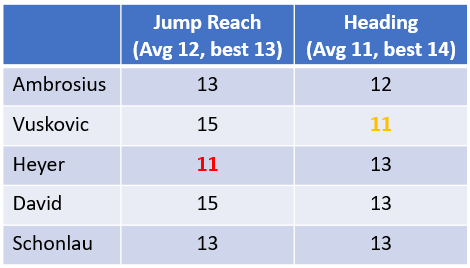
Ideally, I’d want my starting central defenders to be at least 1 or 2 attribute points better than the strikers they’ll play against. The best option I have, aerially, is Jonas David. In terms of the whole package as a CB he’s probably my 3rd or 4th best option. Vuskovic can jump but can’t head it and Schonlau is average at both.
So, we’ve established our defence is poor in the air, but what about on the ground? Have I been blessed with smaller but very nimble defenders, which will enable me to play a high line without fear of counter-attacks?
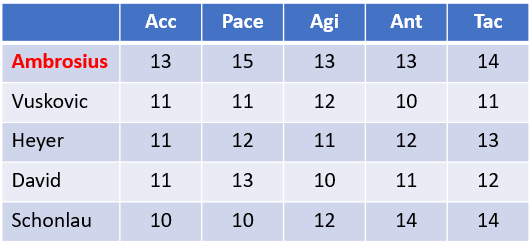
Well… not really. The average attribute for acceleration is 11 and the average pace is 12. Our quickest central defender is Ambrosius, who is injured until November with damaged cruciate ligaments. This might limit my ability to play with a high line, especially against the better opposition.
So, our stable of central defenders can’t head the ball very well and they aren’t very quick. At least they aren’t too bad at anticipating and tackling.
The logical solution to me is to use a back three. As I’m not confident in two of them doing the job, throwing another one in the mix should eliminate the weakness somewhat. Luckily, I’ve explored playing with three CB’s earlier in FM22 so have a pretty good idea how to proceed. Once seen as a defensive, passive option, a 3-man backline can actually create more attacking options as you can fully commit both wingbacks to the attack.
Remember on the WhoScored analysis which said Hamburg were weak at defending counter-attacks? Well, having three central defender spread across the width of the pitch makes countering quite difficult.
We’ve now established I’m going with a back three with marauding wingbacks on either flank, but to decide on player roles for our defence, it all depends on what midfield we put ahead of them.
Afterall, a three man defence with two central midfielders ahead of them would need to function differently than if they the extra comfort blanker of three in the middle of the park. So to finalise our defence, let’s look at the engine-room of any team – the midfield.
CRAFTING A MIDFIELD
My favourite formation so far in Football Manager with three at the back is a 3-5-2 with a DMC. However, this was only because I was the under dog and it kept the team solid and compact and I had a very good deep lying playmaker to kick start counter attacks. With Hamburg I’m gunning for automatic promotion so want to be much more aggressive going forward. So, I’ll try to avoid anyone in the defensive midfield strata.
The table below shows all the midfield options available, rated against the division average for midfielders:

Reis, a recent pick up from Barcelona B, is quite creative and surprisingly aggressive. The versatile Heyer is a good defensive option but lacks the technical ability, as does Kinsombi. Whilst Meffert should be able to keep possession well as stick the boot in when needed, yet lacks vision and off the ball skills.
Suhonen, Chakvetadze and Kittle are all much more suited to roles further up the pitch and I wouldn’t play any of them in a central role without a DMC behind them.
What really sticks out to me is the lack of pace. Chadvetadze is the only player above average for both acceleration and pace. This is worrisome… but I THINK I have a plan.
Removing the three natural attacking midfielders leaves us with four players:

Reis is the best all rounder and has good potential so he’s going straight into the line up, probably in a Deep Lying Playmaker role. The midfield partner to Reis will be between Meffert, the better passer and tackler, or Heyer who is more mobile and better off the ball. This might be a battle which some game time decides.
The team is now starting to take shape:
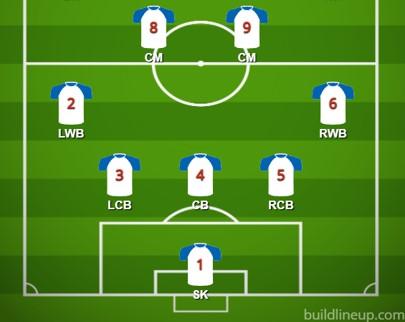
An immediate area of concern is the gap in the centre of the pitch between the central defenders and the midfield duo. If I solve this problem by dropping a midfielder into a defensive role I’ll be missing our in another attacking option. Therefore, the best option is to make the central CB, into a stopper who should be able to step up into that space should the two man midfield wall get breached. Due to the employment of a stopper, the two wide centre backs will be wide central defenders on a defend duty.
Dealing with the lack of pace
How do we deal with a lack of pace in midfield? Well, we don’t ask too much of them, that’s how.
By having the three man backline, spread across the width of the pitch, we can allow the two wingbacks to attack and pin back the opposition fullbacks. All our two central midfielders then need to do is sit in the gap between the defence and attackers.
All we’re asking of them is keep possession, pick up loose balls and make tackles and interceptions. Due to the stopper and the players ahead of the midfield duo, the space they’re expected to operate in shouldn’t be to expansive. We don’t need them to be making dynamic runs off the ball or to be dribbling past 2 or 3 opponents. We’re playing to their strengths whilst reducing the potential impacts of their weaknesses.
A deep lying playmaker and central midfielder, both on support, should do the trick.
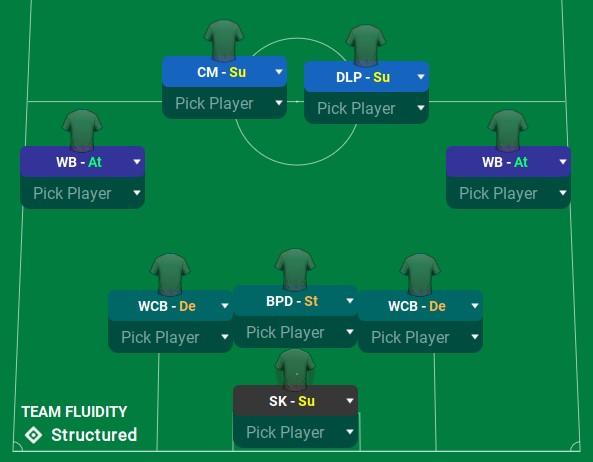
CREATING A BALANCED ATTACK
The Jatta conundrum
Remember earlier when I said I’d normally shoehorn players into a formation and a key player might get left out and get upset etc… well if I’m not careful, this time is could be Bakery Jatta.
On the face of it, in football manager, he’s a right winger who can’t cross, can’t shoot and his left foot is purely for standing on. However, he’s possibly the biggest wildcard in the 2. Bundesliga.

His combination of pace and power make him a formidable player who has the ability to be a match winner. However, due to all his flaws he’s not a player to build a whole system around.
His natural position is out wide, but as he’s very one footed he can only play as a right winger. Of course, doesn’t fit in with the plans for attacking wingbacks pushing up and providing width as they’ll likely get in each others way. I wouldn’t want such a one-footed player in technical role like Inverted Winger or Inside Forward. I’ve even thought about using him as a wingback, but I already have two good options there… so what can we do with him?
Well, as we did with the midfielders, we limit what he has to do and play to his strengths.
So, how to we include Jatta in a three man attack?
To finish off our tactics we have three options available to us, but as he can’t play out wide as a winger, as this will limited the impact of our wingback, so I have to rule out a 2-1 wide set up. He’s also not technically gifted enough to play and find space in the AMC strata in a narrow 2-1 formation.
Therefore, the only remaining is to play him as a striker in a 1-2, along side Robert Glatzel – who is by far our best striking option. Stick with me on this one: he can’t shoot (9) and he’s not composed (7) and he’s not really an aerial threat (10) BUT there’s one role which I think he’s perfect for:
The pressing forward.
His speed, bravery, determination, aggression and work rate are all perfect for this role. In a Pressing Forward role with an attacking mentality he should be able to pressure defenders as well as have the speed to latch onto through balls. Luckily, we have two players who can create those chances for him, as well as be a scoring threat themselves.
Finalising the attacking trio
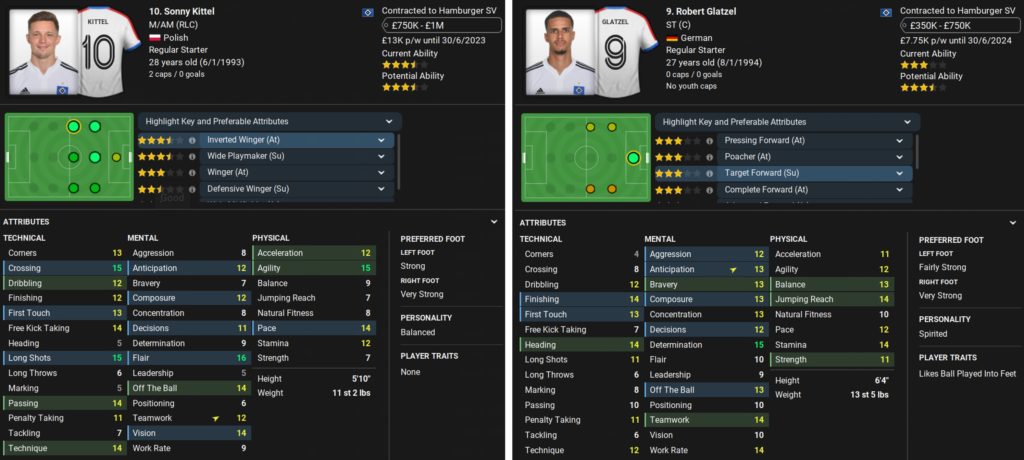
The aforementioned Robert (Bobby) Glatzel is a unit up top and a good target forward at this level. As he likes to receive the ball to his feet, I’ll use him on a support duty. This should allow him to drop a little deeper into the AMC strata, lessening the need for the two centre mids to burst forward. This will also make room for Jatta and Sonny Kittel, to exploit.
I’ve chosen the Shadow Striker role for Sonny Kittel as he’s a technical player and equality adept at creating and scoring.
Between Glatzel, Jatta and Kittel we potentially have the perfect balance of pace, size, creativity and determination.
THE FINAL FORMATION
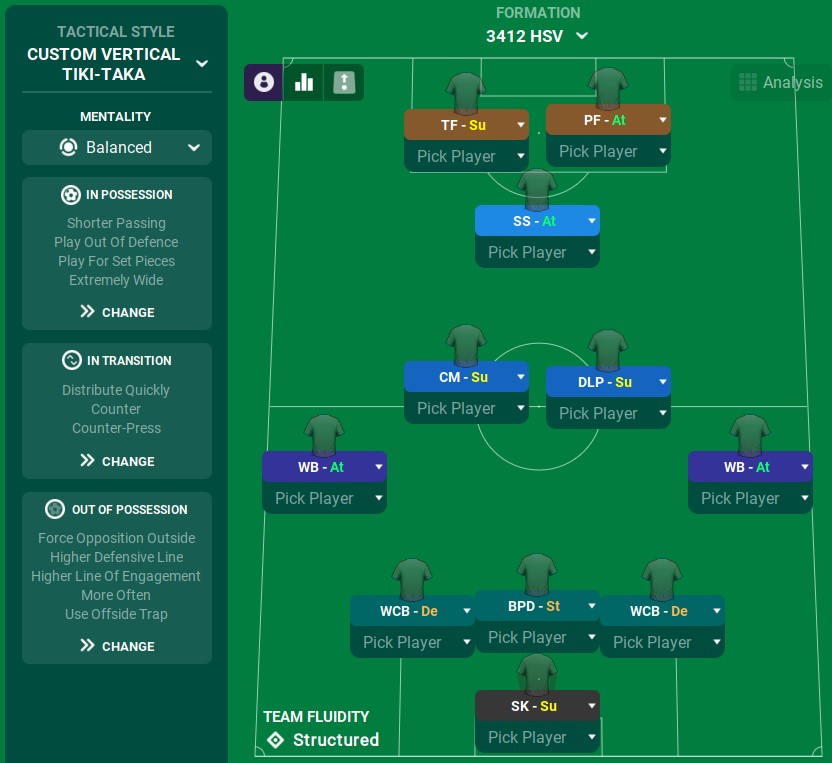
I’ll start off with a balanced mentality which can be tweaked during each game. To get the most out of our wingbacks I’m going to play extremely wide. This should either spread out the opposition defence and create room for the three attackers, or leave one wingback, or both, in acres of space if they choose to stay narrow.
Despite not having much speed in the three central defenders, I’ve opted to go with a high line. I’m pretty confident that their positioning, as well as “holding” central midfielders should help stop a lot of counter-attacking opportunities.
In the image below you can see a snippet of the tactic in action. Jonas David, the “stopper” is carrying the ball out of defence. You can see how wide we’re playing and how a well placed pass would put either wingback in a very dangerous position. Also of note is how small the area is that the two central midfielders have to cover, perfectly counteracting their lack of pace and agility.
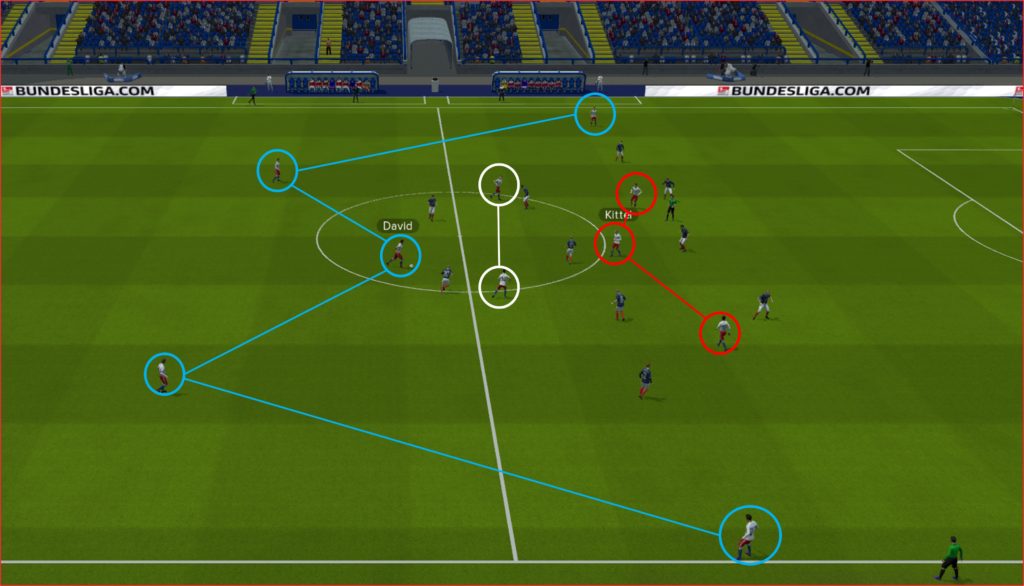
So there we have it. I’ve looked at each position group and identified strengths and weaknesses of players and the units as a whole and created a tactic accordingly.
Obviously, as the save progresses and players come and go, the system and roles will change and adapt.
I’ll play a few months in game – probably to the winter break – and then do some analysis and take a deep dive into the football manager data hub to find out how it’s how it’s going. However, if you were wanting a little hint…

9 thoughts on “Creating a tactic for Hamburg in Football Manager 22 (Part 1)”
Good luck with Jatta, I did Hamburg on FM20 and I found him great in the second division (so much so that I was getting offers for him in January from Bundesliga teams) but then when we got promoted he was absolutely dire in the Bundesliga. I should have cashed in! I used him as a winger though so will be interesting to see how he does as a forward.
Hi – yes, I have to admit that’s one of my worries with him. There was a couple of offers for him in the January window but non beating his valuation, otherwise I think I’d have let him go.
Well thought out tactic and obviously achieving great results. The one part that confuses me is the In Posession instruction Extremely Wide and the Out Of Possession instruction Force Opposition Inside. Surely when attacking wide the gaps when possession is lost will be inside due to making the pitch as large as possible with the Extremely Wide instruction?
Hi, thanks for reading. The OOP setting is set to force opponents OUTSIDE, not inside. Otherwise, yes, you’d be completely correct.
Sorry my bad it was meant to say Outside. What i was trying to ask was that if you attack wide and loose the ball in wide areas the gaps would be inside, so how do you force the Opposition outside when your players are already in wide positions? Does the Extremely Wide instruction mean your whole team are more spread out or just your wide players play as wide as possible?
Ohhh thank you for this. I’ve waited soo long for someone to make content about HSV. Cheers mate!
No problem – there’s much more to come!